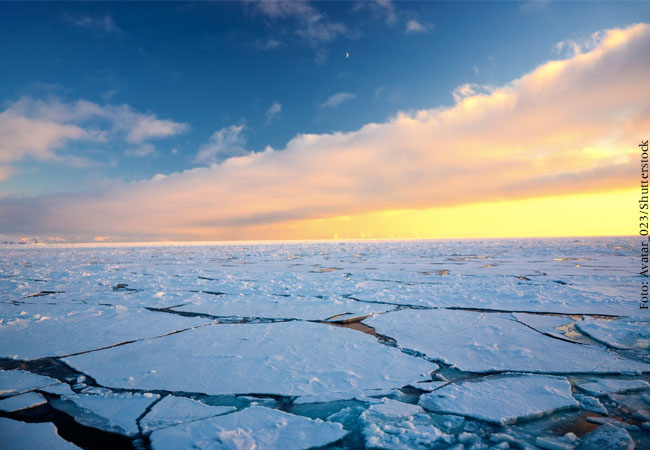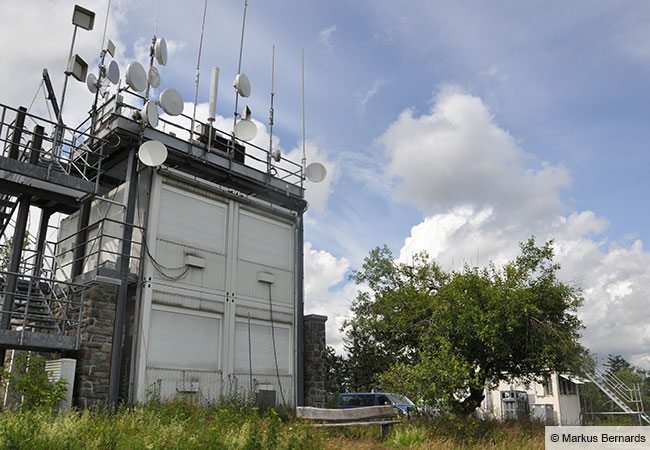
When sea ice melts and the water surface increases, more iodine-containing vapours rise from the sea. Scientists from the international research network CLOUD have now discovered that aerosol particles form rapidly from such iodine vapours, which can serve as condensation nuclei for cloud formation. The CLOUD researchers, among them atmospheric scientists from the Goethe University Frankfurt, fear a mutual intensification of sea ice melt and cloud formation, which could accelerate the warming of the Arctic and Antarctic.
More than two thirds of the earth is covered by clouds. Depending on whether they float high or low, how large their water and ice content is, how thick they are or over which region of the Earth they form, it gets warmer or cooler underneath them. Due to human influence, there are most likely more cooling effects from clouds today than in pre-industrial times, but how clouds contribute to climate change is not yet well understood. Researchers currently believe that low clouds over the Arctic and Antarctic, for example, contribute to the warming of these regions by blocking the direct radiation of long-wave heat from the Earth’s surface.
All clouds are formed by aerosols, suspended particles in the air, to which water vapour attaches. Such suspended particles or aerosols naturally consist of dusts, salt crystals or molecules released by plants. Human activities cause above all soot particles to be released into the atmosphere, but also sulphuric acid and ammonia molecules, which can cluster and form new aerosol particles in the atmosphere. Model calculations show that more than half of the cloud droplets are formed from aerosol particles that have formed in the atmosphere. For the formation of clouds, it is not decisive what the aerosol particles are made of; what matters most is their size: Aerosol particles only become condensation nuclei for cloud droplets from a diameter of about 70 nanometres and up.
In the atmosphere over the sea, aerosols released by humans play a much smaller role in the formation of low clouds than over land. Besides salt crystals originating from sea spray, aerosol particles over the sea mainly originate from certain sulphur compounds (dimethyl sufide) that are released from phytoplankton and react to form sulphuric acid, for example. At least, that is what previous research concluded.
Scientists from the CLOUD consortium have now studied the formation of aerosol particles from iodine-containing vapours. The slightly pungent smell of iodine is part of the aroma of the sea air you breathe when walking along the North Sea. Every litre of seawater contains 0.05 milligrams of iodine, and when it enters the atmosphere, iodic acid or iodous acid is formed through sunlight and ozone. The scientists simulated atmospheric conditions in mid-latitudes and arctic regions in the CLOUD experimental chamber at the CERN particle accelerator centre in Geneva, including cosmic rays simulated by an elementary particle beam.
Their findings: aerosol particle formation by iodic acid takes place very rapidly, much more rapidly than the particle formation of sulphuric acid and ammonia under comparable conditions. Ions produced by cosmic rays further promote particle formation. For the transformation of the molecular iodine into the iodine-containing acids, not even UV radiation and only a little daylight are necessary. In this way, very large aerosol quantities can be formed very quickly.
Atmospheric researcher Prof. Joachim Curtius from Goethe University explains: „Iodine aerosols can form faster than almost all other aerosol types we know. If ions produced by cosmic rays are added, each collision leads to the growth of the molecular clusters.“ Curtius added that this is particularly important because global iodine emissions on Earth have already tripled over the past 70 years. „A vicious circle may have been set in motion here: The pack ice thaws, which increases the water surface area and more iodine enters the atmosphere. This leads to more aerosol particles, which form clouds that further warm the poles. The mechanism we found can now become part of climate models, because iodine may play a dominant role in aerosol formation, especially in the polar regions, and this could improve climate model predictions for these regions.“
The CLOUD experiment (Cosmics Leaving OUtdoor Droplets) at CERN studies how new aerosol particles are formed in the atmosphere out of precursor gases and continue to grow into condensation seeds. CLOUD thereby provides fundamental understanding of the formation of clouds and particulate matter. CLOUD is carried out by an international consortium consisting of 21 institutes. The CLOUD measurement chamber was developed with CERN know-how and is one of the cleanest experimental rooms in the world. CLOUD measurement campaigns use a variety of different measuring instruments to characterise the physical and chemical state of the particles and gases that make up the atmosphere. The team led by Joachim Curtius from the Institute for Atmosphere and Environment at Goethe University Frankfurt develops and operates two mass spectrometers in the CLOUD project to detect trace gases such as iodic acid and iodous acid even in the smallest concentrations.
Publication: Xu-Cheng He, Yee Jun Tham, Lubna Dada, Mingyi Wang, Henning Finkenzeller, Dominik Stolzenburg, Siddharth Iyer, Mario Simon, Andreas Kürten, et. al. Role of iodine oxoacids in atmospheric aerosol nucleation, Science 05 Feb 2021: Vol. 371, Issue 6529, pp. 589-595, https://doi.org/10.1126/science.abe0298









